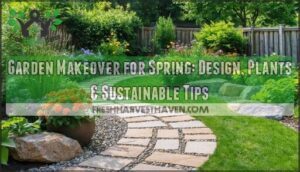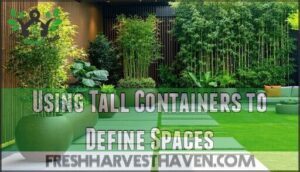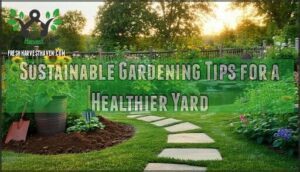This site is supported by our readers. We may earn a commission, at no cost to you, if you purchase through links.

Native plants slash water use by up to 60%, while gravel gardens and regenerative soil practices cut maintenance in half. You’ll create outdoor rooms that work harder, look sharper, and free up your weekends.
Table Of Contents
- Key Takeaways
- Transform Your Garden With Spring Design Ideas
- Choose The Right Plants for Spring Makeovers
- Sustainable Gardening Tips for a Healthier Yard
- Enhance Outdoor Living Spaces for Spring
- Easy Maintenance and Smart Garden Upgrades
- Frequently Asked Questions (FAQs)
- What are some DIY garden makeover ideas?
- How do you make a Spring Garden more creative?
- How do you plan a Spring Garden?
- What is a Spring Gardening checklist?
- How do you make a garden look better?
- How do you make a garden look good all year long?
- How much should I budget for spring?
- What tools are essential for garden makeovers?
- When should I start planning spring changes?
- Can I makeover my garden without professionals?
- Conclusion
Key Takeaways
- Small strategic changes—like mixing paver materials, carving curved beds, or placing tall containers—can transform your yard without a complete teardown while giving you full control over how your space functions.
- Native plants slash water use by up to 60% and cut maintenance time in half, while regenerative practices like no-till gardening and composting build healthier soil that works for you instead of against you.
- Layering annuals, perennials, and shrubs with staggered bloom times creates year-round interest and eliminates the need to replant every season, keeping your garden looking sharp with minimal effort.
- Well-executed landscape upgrades with native plantings, clean hardscaping, and functional outdoor living spaces can boost your home’s resale value by 10 to 20 percent while making your yard a space you actually want to use.
Transform Your Garden With Spring Design Ideas
Spring’s here, and it’s time to break free from boring backyard design. Your outdoor space should reflect your style and work the way you want it to.
Here are five bold ways to transform your garden this season.
Mixing Patio Paver Materials for Visual Interest
By playing with different paver textures, colors, and shapes, you can turn a flat patio into something that feels intentional and eye-catching. Here’s how to break free from boring outdoor living:
- Blend material textures – pair smooth concrete with rough stone for contrast
- Mix paver patterns – combine herringbone with running bond layouts
- Layer color schemes – use darker border designs to frame lighter interior sections
- Alternate shapes – drop hexagonal pavers into rectangular grids
This texture mix transforms your yard’s landscape design without a full garden makeover.
Creating Unique Patios Using Salvaged Materials
Once you’ve locked in your paver layout, reclaimed wood, vintage brick, and salvaged stone can give your patio a one-of-a-kind character that no store-bought kit can match. This patio recycling approach to landscape design turns material reuse into eco-friendly art while slashing costs.
| Salvage Design Source | Material Reuse Ideas | Outdoor Living Impact |
|---|---|---|
| Old barn timbers | Bench frames, table legs | Rustic seating zones |
| Broken concrete slabs | Mosaic paver inserts | Bold texture contrast |
| Reclaimed bricks | Border edging, fire pit ring | Heritage garden makeover |
| Weathered decking | Planter box sides | Vertical DIY garden displays |
| Vintage metal gates | Privacy screens, trellises | Repurposed furniture accents |
Hunt architectural salvage yards and demo sites for one-off finds that anchor your outdoor living story.
Adding Curved Beds and Statement Corners
Straight lines box you in—curves and corner plantings break the grid and let your garden breathe. Curved garden beds soften harsh 90-degree angles and add movement to your yard transformation.
Fill blank corners with layered shrubs, perennials, and colorful annuals to create bold yard accents that anchor your landscape design. Soft landscaping with flowing garden borders turns forgotten zones into statement features that make your garden makeover feel intentional and alive.
Using Tall Containers to Define Spaces
Tall container planters work like garden walls—they separate your patio from the lawn without building fences or digging borders. Vertical gardening with tall planters gives you instant space division and garden screening.
Line your patio edge with containers filled with grasses, bamboo, or shrubs to create a vertical garden boundary that you can move or rearrange. This container placement strategy transforms your garden makeover into a flexible garden design that adapts with the seasons.
Incorporating Outdoor Rugs and Colorful Decor
An outdoor rug transforms bare concrete into a room without walls—add bold patterns and warm tones to anchor your patio and give it personality that rivals any indoor space. Rug placement sets the foundation for your outdoor living setup.
Layer in patio textiles like cushions and throws using a simple color scheme—warm oranges or bright blues work for a spring gardening vibe. These outdoor accents tie your garden design together and make your garden makeover feel complete.
Choose The Right Plants for Spring Makeovers
Your plant choices set the tone for spring and every season after. Native and keystone species anchor your garden, while a smart mix of annuals, perennials, and shrubs keeps the show going all year.
Here’s how to build a lineup that works with your soil instead of fighting it.
Benefits of Native and Keystone Plants
Native plants work with your local ecosystem, not against it. They cut water use by up to 60% and slash maintenance time by half. Keystone species like oaks support hundreds of butterfly and moth species, building biodiversity from the ground up.
Their deep roots improve soil health and reduce erosion by 35%, while needing 80% less fertilizer. This is ecosystem resilience in action—planting flowers that actually strengthen your landscape instead of draining it.
Native plants strengthen your landscape with deep roots that improve soil health by 35% and slash fertilizer needs by 80%
By incorporating native plant species, homeowners can create a more balanced and sustainable outdoor space.
Planting Annuals, Perennials, and Shrubs for Season-Long Appeal
Layering annuals, perennials, and shrubs creates garden diversity that delivers nonstop color from frost to frost. Start with soil preparation—add compost to boost fertility before planting. Position tall shrubs as structure, mid-height perennials for reliable bloom timing, and annuals as quick fillers.
This plant layering approach fosters ecological balance while giving you total control over your spring gardening tips and garden makeover vision.
Stagger bloom timing for continuous interest with minimal plant care tips required. To achieve this, consider using cold tolerant plants that can thrive in cooler temperatures.
Flowers and Bulbs to Plant in Early Spring
Early spring is your chance to get bulbs in the ground before the soil warms—think tulips, daffodils, and crocuses for instant curb appeal by mid-March. Pair spring flowering bulbs with early bloomers like pansies and primrose to layer petal varieties and garden colors.
This approach to planting spring flowers gives you full command over spring blooms while your neighbors wait for warmth.
Master bulb care by planting six inches deep in well-draining soil enriched with compost.
Multi-Season Interest Plant Selections
Your garden doesn’t get the day off after spring—choosing plants with multi-season interest means you stay in control while others scramble to replant every few months. Go for garden layers combining evergreens for year-round greenery, shrubs with color texture through berries or bark, and perennials with staggered seasonal bloom cycles.
This plant diversity in your spring landscaping delivers continuous garden inspiration and transforms your garden makeover into a self-sustaining landscape design that outperforms single-season plantings.
Sustainable Gardening Tips for a Healthier Yard
Your spring garden can do more than look good—it can work with the earth, not against it. Sustainable practices build healthier soil, conserve water, and reduce the time you spend fighting weeds and pests.
Here’s how to turn your yard into a low-maintenance, eco-friendly space that thrives season after season.
Composting and Soil Improvement Techniques
Think of compost as black gold for your garden—it transforms lifeless dirt into a living ecosystem that feeds your plants and builds resilience from the ground up. Start your compost station with kitchen scraps and yard waste to boost organic matter.
Soil testing reveals what your garden actually needs before you add organic fertilizer. Compost tea delivers nutrients and nurtures beneficial microbes that drive nutrient cycling.
Layer finished compost into mulch beds to improve soil structure and support year-round garden maintenance.
No-Till and Regenerative Gardening Practices
Regenerative gardening flips the script on traditional soil management by building fertility instead of depleting it. No-till methods protect the living network beneath your feet—leaving soil undisturbed preserves microbes and earthworms that drive nutrient cycling and climate resilience. These regenerative techniques gained traction as no-till gardening expanded to 14% of new spring garden makeovers in 2025, up from 8% in 2022.
Here’s how to break free from old habits:
- Skip the tilling—disturbing soil releases carbon and destroys beneficial organisms
- Layer organic mulching over beds to suppress weeds and feed the soil slowly
- Plant cover crops between seasons to protect bare ground and fix nitrogen
- Use organic fertilizer sparingly since healthy soil does most of the work
Cover cropping and composting boosted adoption by 22% among surveyed gardeners in 2025. This isn’t just sustainable gardening—it’s soil regeneration that makes your garden makeover work harder with less effort.
Gravel Gardens and Water-Saving Ideas
Gravel gardens slash water bills and drought stress without sacrificing style. These low-maintenance landscapes appeared in 11% of professionally designed spring projects in 2025, proving that water conservation and bold yard makeover ideas go hand in hand.
Gravel paths channel rainwater harvesting into permeable zones that prevent soil erosion while drought-tolerant plants thrive in the gaps. Pair gravel with a small water feature for contrast, and you’ve built landscape design tips into garden makeover ideas that break free from thirsty lawns.
Using Mulch and Eco-Friendly Weed Barriers
Mulch doesn’t just stop weeds—it starves them out while feeding your soil, and eco-friendly barriers keep roots cool without suffocating the ground beneath.
Layer three inches of organic mulch for maximum weed control and soil health:
- Shredded bark locks moisture in and breaks down into rich compost.
- Cardboard barriers under mulch block light without chemicals.
- Garden edging pairs with mulch to finish clean landscaping ideas.
These organic landscaping moves turn yard makeover plans into low-maintenance wins.
Enhance Outdoor Living Spaces for Spring
Your backyard isn’t just grass and plants—it’s your personal escape that should work as hard as you do. Spring’s the perfect time to turn that outdoor space into something you’ll actually want to use.
Here’s how to build a patio area that breaks free from boring and gives you real comfort on your terms.
Creating Comfortable Patio and Seating Areas
A patio that feels like a second living room doesn’t happen by accident—it takes the right furniture, layout, and a few smart tricks to pull your whole outdoor space together.
Start by zoning your seating area with weather-resistant garden furniture positioned for conversation. Add comfortable textiles like cushions and outdoor rugs to soften hard surfaces.
Layer in outdoor lighting to extend usability after dark and define your outdoor living spaces with purpose.
Installing Outdoor Fireplaces for Versatility
One outdoor fireplace can flip your patio from a three-season spot into a year-round retreat where you’ll actually want to hang out past sunset. Choose fireplace designs that match your patio layouts—stone adds rustic weight, sleek metal fits modern lines.
Outdoor heating creates a warm ambiance that draws people in, making adaptable seating arrangements work harder across seasons.
A fire pit anchors your outdoor living spaces and becomes the focal point of your outdoor decor and landscape design.
Choosing Simple Color Schemes and Lighting
Color choices lock your outdoor room together—pick two or three shades that echo your home’s exterior and stick to them across cushions, planters, and lighting fixtures. Color harmony transforms random spring garden decor into intentional garden decoration ideas.
Layer ambient lighting at different heights—string lights overhead, path fixtures low, and uplights on garden accents—to shift the mood once the sun drops and make your garden makeover ideas feel complete.
Using Container Gardens as Living Boundaries
Tall pots filled with evergreens or ornamental grasses draw a soft line between your patio and lawn without the commitment of a fence or the hassle of digging permanent beds.
Arrange containers in staggered clusters as garden dividers—you control space separators by shifting container placement mid‑season.
Vertical gardens built from stacked planters create instant living privacy screens that block sightlines while keeping your garden makeover ideas flexible and bold.
Hiding Eyesores With Strategic Plantings
Your air conditioner, utility box, or compost bin doesn’t need to steal the show—screen it with a dense wall of shrubs or tall ornamental grasses and reclaim that corner as part of your design instead of an apology.
Strategic landscaping turns eyesore hiding into garden renovation:
- Evergreen hedges give year‑round yard camouflage and double as windbreaks in exposed corners.
- Bamboo clumps rise fast, creating living screens that block utility boxes without looking forced.
- Ornamental grasses soften hard edges while masking mechanical equipment with movement and texture.
- Climbing vines on trellises wrap chain‑link or meter panels into vertical garden concealment features.
- Layered shrub borders blend plantings into the landscape so gardening projects feel intentional, not reactive.
Easy Maintenance and Smart Garden Upgrades
A garden that practically takes care of itself? That’s not a pipe dream—it’s just smart planning. The right tools and strategies can slash your maintenance time while keeping your yard looking sharp all season.
Here’s how to set up a low-effort, high-impact garden that gives you more freedom to enjoy it.
Setting Up Adjustable Sprinkler Systems and Water Hoses
If you’re tired of dragging hoses around or chasing down dry spots, it’s time to set up a system that waters for you. An adjustable sprinkler like the Gardena ZoomMaxx Sprinkler covers wide areas without constant repositioning. Pair it with a durable Gardena 60 ft hose that reaches every corner.
For beds and borders, drip irrigation delivers water right to the roots, cutting waste and freeing up your time.
Selecting Durable Landscape Edging and Stakes
Sharp edges keep your garden from blurring into chaos—durable edging is the backbone that holds the whole design together. Metal edging and landscape borders slice clean lines between beds and lawn, stopping mulch drift and grass creep.
Pound in garden stakes or fence posts to anchor edging materials—they won’t budge when you mow. Add a weed barrier underneath yard edging for double protection. Your landscape stays defined, season after season.
Applying Organic Fertilizers and Regular Watering
Feed your plants like you mean it—organic granular fertilizer delivers nutrients without the chemical hangover, and a steady watering rhythm keeps roots strong when spring kicks into high gear. Scatter fertilizer around planting flowers and work it into the soil surface to boost soil quality with organic matter.
Set up a simple watering system or drip irrigation for water conservation—your garden maintenance gets easier, and roots drink deep without waste.
Low-Maintenance Plant Choices and Mulching
Once your plants are fed and watered, stack the deck in your favor with drought-tolerant picks and a thick blanket of mulch—less fuss, fewer weeds, and more time to enjoy what you’ve built.
Choose native plantings adapted to your yard’s conditions for serious weed control and low-effort landscape upkeep.
Layer two to three inches of organic mulch types over garden bedding to lock in moisture, condition soil, and slash maintenance to near zero.
Boosting Resale Value With Well-Kept Gardens
Beyond the immediate payoff of a beautiful yard, smart Landscape Maintenance and thoughtful Garden Renovation translate directly to Property Value gains.
Well-executed Landscape Design with native plants, clean hardscaping, and functional Green Spaces can lift your home’s resale price 10 to 20 percent—turning every hour of Yard Improvement and Outdoor Investments into serious equity when it’s time to sell.
Frequently Asked Questions (FAQs)
What are some DIY garden makeover ideas?
Start small with what’s already in your yard. Mixing salvaged materials for Budget Landscaping creates one-of-a-kind patios.
Try curved garden beds to soften corners or tall containers that define spaces—both solid DIY Garden moves that transform Yard Decor.
How do you make a Spring Garden more creative?
Mix creative landscaping with unexpected garden art and bold spring florals.
Try quirky garden decor ideas paired with eco-friendly spring container ideas.
Layering texture and surprise keeps your design fresh and full of personality.
How do you plan a Spring Garden?
Garden planning starts with yard mapping and soil testing. 62% of Gen Z gardeners increased garden budgeting in
Sketch your space, test pH levels, then build garden timelines around spring themes for planting flowers and bulbs that match your vision.
What is a Spring Gardening checklist?
Tackle yard cleanup first: prune dead stems, rake leaves, and prep your beds. Test your soil, sharpen tools, and set aside a Garden Planning budget for new plants, mulch, and Spring Landscaping Ideas that’ll give your space a total refresh.
How do you make a garden look better?
You don’t need to tear it all up to make it shine. Plant Pruning cleans up unruly growth, and improved Soil Quality feeds healthier roots.
Yard Decor anchors your Landscape Design, while Garden Paths draw the eye forward. Spring Garden Ideas spark fresh layouts, and strategic Garden Lighting extends evening enjoyment beyond sunset.
How do you make a garden look good all year long?
You can’t break free from seasonal slump without layering your garden design. Choose plants with multi-season interest and winter structure. Use evergreens as your backbone.
Mix annuals with perennials for year-round bloom. Add soil health practices and seasonal color rotations.
That’s how landscape design turns a one-hit wonder into lasting landscaping inspiration.
How much should I budget for spring?
Most homeowners spent $671 on garden expenses in For your spring garden makeover, budget planning should account for yard investments like plants, mulch, and materials.
Cost estimation varies, but setting aside $500–$1,000 covers most spring financing needs for lawn care tips and yard makeover tips.
What tools are essential for garden makeovers?
You’ll want pruning shears, hand trowels, garden forks, and rakes for planting and shaping beds.
Add soil testers, irrigation systems, and power equipment like tillers to simplify DIY garden projects and bring landscape inspiration to life.
When should I start planning spring changes?
Proper seasonal tasks and timeline creation begin late winter. Check your weather forecast for frost dates. Then sketch garden design and styling ideas while soil thaws.
Spring planning lets you order plants early and tackle garden prep before planting season hits full swing.
Can I makeover my garden without professionals?
You can absolutely tackle your own DIY Garden Makeover without hiring pros. Budget Landscaping and Self-Guided Design work when you use Garden Planning steps.
These DIY Gardening and Yard Renovation tactics give you control. Spring Garden Ideas and Gardening Tips make Garden Renovation accessible.
Conclusion
One weekend can flip the script on years of compromise. A garden makeover for spring doesn’t demand flawlessness—it thrives on bold choices: curved beds that carve new flow, native plants that cut your workload in half, and strategic hardscapes that turn dead zones into destinations.
You’ve got the blueprint. Now stake your claim, plant with purpose, and watch your yard become the space you actually want to spend time in.
- https://www.mikesevergreen.com/landscaping-tips/spring-gardening-trends-in-2025/
- https://www.gardenary.com/blog/garden-trends
- https://tomlinsonbomberger.com/blog/dig-deep-2025-garden-design-trends-for-a-sustainable-modern-outdoor-space/
- https://gardeningfamily.com/home-gardening-statistics/
- https://www.sure-green.com/blog/spring-2025-the-ultimate-guide-to-sustainable-landscaping.html












